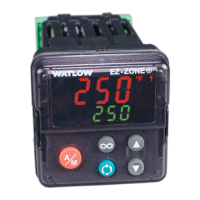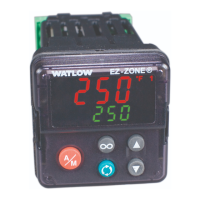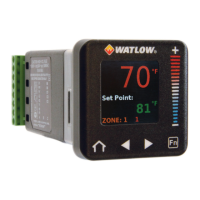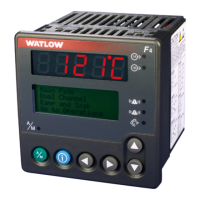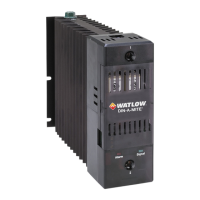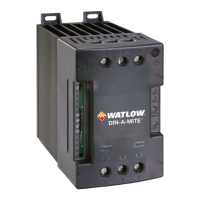Watlow EZ-ZONE
®
PMI Controller • 183 • Chapter 9 Features
After you program the controller and verify proper operation, select Save Settings As Usr.s
(Setup Page, Global Menu) to save the settings into either of two les (sEt1 or sEt2) in the
control memory.
Note:
Saving the settings overwrites any previously saved collection of settings. Be sure to docu-
ment all the controller settings.
If the settings in the controller are altered a user can return the controller to one of three
settings. If previously saved, sEt1 or sEt2 can be restored as well as the factory fCty
settings. Navigate to the Setup Page, Global Menu to nd the Restore USr.r prompt. A digi-
tal input or the Function Key can also be congured to restore parameters.
Note:
When restoring factory defaults, I/O assemblies for Modbus, DeviceNet, Profibus and Eth-
ernet along with the zone address will be overwritten when restoring factory defaults.
Tuning the PID Parameters
Autotune
When an autotune is performed on the
EZ-ZONE
®
PM, the set point is used to calcu-
late the tuning set point.
For example, if the active set point is 200°
and Autotune Set Point A.tsp (Operations
Page, Loop Menu) is set to 90 percent, the
autotune function utilizes 180° for tuning.
This is also how autotuning works in previ-
ous Watlow controllers. In addition, chang-
ing the active set point in previous control-
lers causes the autotune function to restart;
where with the EZ-ZONE PM changing the
set point after an autotune has been started
has no affect.
A new feature in EZ-ZONE PM products will allow set point changes while the control is
autotuning, this includes while running a prole or ramping. When the auto tune is initially
started it will use the current set point and will disregard all set point changes until the tun-
ing process is complete. Once complete, the controller will then use the new set point. This
is why it is a good idea to enter the active set point before initiating an autotune.
Autotuning calculates the optimum heating and/or cooling PID parameter settings based on
the system's response. Autotuning can be enabled whether or not TUNE-TUNE+
®
is enabled.
The PID settings generated by the autotune will be used until the autotune feature is rerun,
the PID values are manually adjusted or TRU-TUNE+
is enabled.
To initiate an autotune, set Autotune Request AUt (Operations Page, Loop Menu) to yEs.
You should not autotune while a prole is running. If the autotune cannot be completed in 60
minutes, the autotune will time-out and the original settings will take effect.
Depending on which loops are being tuned the lower display may ash tUn1 or tUn2 and
the set point while the autotuning is underway. The temperature must cross the Autotune Set
Point ve times to complete the autotuning process. Once complete, the controller controls
Time
Temperature
Autotune begins
Process Set Point
Autotune Set Point
(90 percent of Process Set Point)
Autotune complete
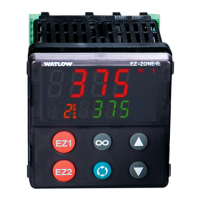
